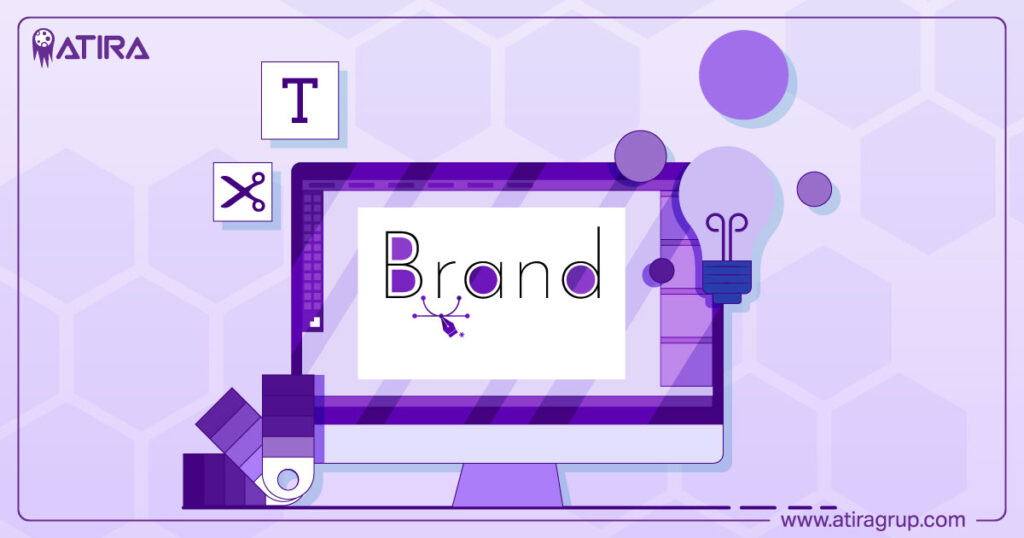Visual identity is how your brand looks and feels. It includes your logo, colors, fonts, and images. A strong visual identity sets you apart, builds trust, and makes your brand memorable. In this article, you’ll learn the key elements, benefits, and steps to create and maintain an effective visual identity.
Key Takeaways
- A strong visual identity comprises key components such as logo design, color palette, and typography, which together shape the brand’s overall image and influence customer perception.
- Maintaining a consistent visual identity enhances brand recognition, fosters customer trust, and can lead to long-term loyalty by presenting a unified brand message across multiple channels.
- Creating an effective brand identity involves systematic steps including brand discovery, design development, and implementation of guidelines, with professional designers playing a crucial role in ensuring cohesion and alignment with brand values.
Table of Contents
Understanding Visual Identity
Visual identity represents a brand’s personality through various visual elements, including a visual element such as:

- Logos
- Color palettes
- Typography
- Imagery
These components work together to create a recognizable representation that differentiates the brand and builds trust with its audience.
Whether it’s the sleek design of Apple’s products or the friendly interface of Slack, a strong visual identity is crucial for brand recognition and establishing an emotional connection with customers.
The importance of visual identity important cannot be overstated. It shapes public perception and influences how customers feel about a brand. Effective visual identity not only creates a lasting impression but also helps in communicating the brand’s values and ethos. Defining the brand’s characteristics, purpose, and mission sets a foundation for consistent visual elements throughout the branding process.
Utilizing visuals effectively conveys messages and enhances customer interest, making visual identity a powerful tool in any brand’s arsenal. Understanding and utilizing key components of visual identity helps brands craft a cohesive appearance that resonates with their audience and endures over time.
Key Components of a Strong Visual Identity
A strong visual identity is built on several key components, each playing a vital role in how the brand is perceived. These components include logo design, color palette selection, and typography choices. Together, they create a cohesive and recognizable visual brand identity that reflects the brand’s personality and values.

Each component plays a unique role in shaping the brand’s overall image.
Logo Design
A logo serves as a distinctive mark or symbol that represents the business. It is memorable and reflects the brand ethos. Key characteristics of a successful logo include uniqueness, scalability, simplicity, and effectiveness in both color and black-and-white formats. When creating a logo, it should resonate with the target audience and reflect the essence of the brand.
Consider the Apple logo, which signifies quality, trustworthiness, and cutting-edge products. This logo is an excellent example of effective logo design that is both memorable and impactful. A well-designed logo not only differentiates the brand from competitors but also creates a strong brand image that consumers can easily recognize and trust.
Online logo generators offer a practical option for businesses on a budget, but careful selection of colors, fonts, and images is necessary to avoid a disjointed visual identity. A professional designer can ensure that the logo and other visual elements align with the brand’s values and goals, creating a cohesive and effective brand identity.
Color Palette Selection
The selection of a color palette is a critical aspect of developing a solid visual identity. Color psychology plays a significant role in the creative process, as different colors evoke various emotions and reflect brand identity. For instance, blue implies trust, while red can evoke excitement and urgency. Understanding color theory is crucial for choosing brand colors that evoke specific moods and guide design decisions.
A well-selected color palette should be functional, appropriate, and versatile, enhancing brand recognition and ensuring consistency across various contexts.
A professional designer can offer expertise in choosing a color palette that aligns with the brand’s identity and goals.
Typography Choices
Typography is another essential component of a strong visual identity. The choice of typography can establish a brand’s mood and personality, significantly influencing customer perception. Font choice should align with the aesthetic and tone of the brand, ensuring that the typefaces complement the brand’s personality and remain legible across different mediums.
Main categories of fonts for brand design include formal/traditional fonts and modern/tech-savvy fonts. For example, a modern brand might prefer a sleek sans-serif font, while a traditional brand might opt for a classic serif font.
Effective typography choices enhance the overall visual brand identity, ensuring it stands out in the market.
Benefits of a Consistent Visual Identity
Before:
Maintaining a consistent visual identity offers numerous benefits for a brand. Cohesive branding that embodies a unique visual identity enhances recognition and differentiation in a competitive market. A unified brand presentation across various marketing channels not only enhances recognition but also fosters trust among customers. Maintaining consistent messaging and design across various media ensures a cohesive brand identity.

After:
Maintaining a consistent visual identity offers numerous benefits for a brand:
- Enhances recognition and differentiation in a competitive market.
- Fosters trust among customers through a unified brand presentation across various marketing channels.
- Ensures cohesive brand identity by maintaining consistent messaging and design across various media.
A successful visual identity fosters loyalty by establishing a trustworthy and recognizable presence. Consistency in branding can lead to long-term customer loyalty and a stronger emotional connection with the audience. Moreover, a cohesive visual identity can enhance a brand’s authority in its industry, making it more likely to be perceived as a leader.
Establishing brand guidelines simplifies the maintenance of a consistent look and feel across all branding materials. Utilizing digital asset management tools can help ensure that visual assets align with branding guidelines, further supporting a reliable customer experience and fostering brand loyalty. Clear communication of brand identity can differentiate a business from its competitors, making it more memorable and impactful.
Steps to Create an Effective Brand Identity
Creating an effective brand identity involves a strategic brand strategy and systematic approach. The process can be broken down into several key steps: brand discovery and analysis, design development and iteration, and implementation and guidelines.

Each of these steps plays a crucial role in developing a strong visual identity that resonates with the target audience and supports the brand’s goals.
Brand Discovery and Analysis
The first step in creating a brand identity is brand discovery and analysis. Understanding the brand’s personality, mission, and desired emotional impact is critical for defining its visual identity. An effective visual identity must reflect the essence of what the brand does and cares about. Crafting buyer personas clarifies the target audience’s needs, aiding in tailoring the visual identity to resonate with them.
Developing detailed audience profiles includes psychographics and visual preferences, which are essential for effectively catering to the target market. Analyzing demographics such as age, gender, income, and education can deepen the understanding of the audience and their visual preferences. Recognizing the audience’s challenges helps in creating impactful visual assets that address their needs and preferences.
Conducting competitor research is essential to identify unique niches and differentiate the brand in the market. Understanding the market context and the audience’s challenges lays the groundwork for a successful visual identity that communicates effectively and resonates with potential customers.
Design Development and Iteration
Once the brand discovery and analysis are complete, the next step is design development and iteration. This involves creating mood boards, conceptual sketches, and iterative design to refine visual elements and ensure their effectiveness. Conducting workshops, interviews, surveys, and competitive analysis provides foundational insights for establishing a visual identity that aligns with the brand’s goals.
Feedback loops during design help refine visual elements to ensure they resonate with the target audience. Continuous iteration and refinement lead to a solid visual identity that effectively communicates brand values and stands out in the market.
Implementation and Guidelines
The final step in creating an effective brand identity is implementation and establishing guidelines. A unified brand style guide is vital for maintaining consistency across various channels. The purpose of establishing a visual identity guide is to maintain brand standards and ensure visual identity consistency. A brand manual should include detailed usage rules for every component of the visual identity, making it easier for everyone on the team to adhere to the guidelines.
All team members, from marketing to customer service, should access the visual style guide to maintain cohesive and consistent brand presentation.
Regular monitoring and updates are vital for maintaining a visual identity. Visual identities need to be somewhat flexible and adaptable while evolving with the brand, ensuring they remain relevant and effective over time.
Real-World Examples of Successful Visual Identities
Learning from real-world examples of successful visual identities can provide valuable insights and inspiration. Brands like Slack and Apple have created compelling visual identities that are both memorable and effective.

Let’s explore how these brands have achieved success through their brand’s visual identity and their brand’s values and brand’s identity.
Slack
Slack’s visual identity is known for being friendly and engaging, setting it apart from more corporate competitors. The company uses casual messaging and a calming interface, incorporating fun elements like emojis to create a unique and approachable brand personality. These design strategies enhance Slack’s brand recognition and make it a favorite among users.
Slack’s focus on user-friendly design and approachable messaging has cultivated a visual identity that resonates with its audience. The use of white space and clean design elements further enhances the user experience, making Slack’s interface both functional and visually appealing.
Apple
Apple is renowned for creating a visual identity that embodies both simplicity and sophistication. The introduction of the flat design aesthetic in iOS marked a significant innovation in Apple’s visual identity, moving away from skeuomorphic designs. By maintaining consistency in its branding with a cohesive color palette and typography across its products and marketing materials, Apple has successfully evolved its identity while retaining brand recognition.
Apple’s ability to balance innovation with established visual elements has made its visual identity iconic. Apple’s dedication to simplicity and elegance in design has made a lasting impression, establishing it as a leader in both technology and design.
Maintaining and Evolving Your Visual Identity
Maintaining and evolving a visual identity is crucial for staying relevant and effectively connecting with the audience. Regular assessments of a brand’s visual identity help ensure that it remains aligned with market trends and customer preferences. A visual identity should adapt to changes in market trends while staying true to the brand’s core values and mission.

Engaging with customers continuously offers insights into the perception of a brand’s visual identity, guiding necessary adjustments to ensure it remains effective and resonant. Balancing innovation with the need to preserve elements that resonate with existing customers is key to evolving a visual identity successfully.
The Role of Professional Designers
Professional designers are key to establishing a cohesive visual identity and strategic approach that represents the brand effectively. They specialize in creating unified visual identities and collaborate closely with marketing teams to communicate brand values. By ensuring that all visual elements align with the brand’s mission and values, professional designers create a unified brand story that enhances visibility and recognition among target audiences.

Successful graphic design significantly enhances brand visibility and recognition, driving brand success. Professional designers bring expertise and creativity to the table, ensuring that the visual identity is both unique and effective. Their collaboration with marketing teams helps create a well-designed identity that resonates with prospective customers and supports the brand’s overall goals.
Summary
In conclusion, a compelling visual identity is essential for brand success. It represents the brand’s personality, values, and mission, creating a recognizable and trustworthy presence in the market. By understanding the key components of a visual identity, such as logo design, color palette selection, and typography choices, brands can develop a strong and cohesive visual brand identity that resonates with their audience.
Maintaining consistency and evolving the visual identity over time ensures that it remains relevant and effective. Collaboration with professional designers and continuous engagement with customers are crucial for creating a visual identity that stands the test of time. By following the steps outlined in this guide, brands can achieve a unique and effective visual identity that supports their overall brand strategy and drives success.
Read more:
Creating a Strong Corporate Identity: Key Elements and Best Practices
Creating A Strong Brand Image: Key Elements & Practical Tips
Frequently Asked Questions
What is visual identity?
Visual identity encompasses the visual elements that embody a business’s values and personality, such as logos, color palettes, typography, and imagery. This collection of design components creates a cohesive brand presence.
Why is a consistent visual identity important?
A consistent visual identity is crucial as it enhances brand recognition and fosters trust, creating a cohesive presence across multiple marketing channels. This uniformity ultimately strengthens the overall impact of your brand.
How can I choose the right color palette for my brand?
Choosing the right color palette for your brand involves understanding color psychology and theory to evoke the desired emotions and enhance your brand identity. Additionally, ensure the palette is functional and versatile for various applications.
What are the benefits of hiring a professional designer for my brand’s visual identity?
Hiring a professional designer for your brand’s visual identity ensures a cohesive representation that aligns with your mission and values, enhancing visibility and recognition. Their expertise supports a strong brand strategy that can significantly impact your overall success.
How can I maintain and evolve my brand’s visual identity?
To maintain and evolve your brand’s visual identity, regularly assess market trends and engage with your customers. Striking a balance between innovation and preserving resonant elements ensures successful evolution.


